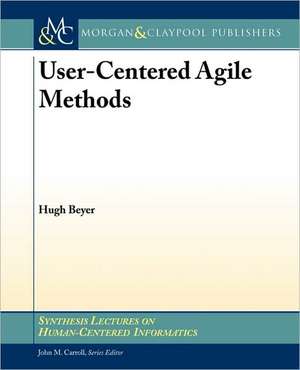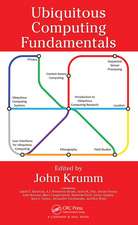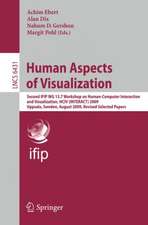User-Centered Agile Methods: Synthesis Lectures on Human-Centered Informatics
Autor Hugh Beyeren Limba Engleză Paperback – 2 iun 2010
| Toate formatele și edițiile | Preț | Express |
|---|---|---|
| Paperback (2) | 140.75 lei 3-5 săpt. | |
| Springer International Publishing – 15 iun 2010 | 140.75 lei 3-5 săpt. | |
| Morgan & Claypool – 2 iun 2010 | 204.53 lei 6-8 săpt. |
Din seria Synthesis Lectures on Human-Centered Informatics
-
 Preț: 303.07 lei
Preț: 303.07 lei - 20%
 Preț: 166.09 lei
Preț: 166.09 lei - 20%
 Preț: 160.88 lei
Preț: 160.88 lei - 20%
 Preț: 136.65 lei
Preț: 136.65 lei - 20%
 Preț: 241.35 lei
Preț: 241.35 lei - 20%
 Preț: 140.75 lei
Preț: 140.75 lei - 20%
 Preț: 289.49 lei
Preț: 289.49 lei - 20%
 Preț: 301.96 lei
Preț: 301.96 lei - 20%
 Preț: 353.93 lei
Preț: 353.93 lei - 20%
 Preț: 178.13 lei
Preț: 178.13 lei - 20%
 Preț: 352.89 lei
Preț: 352.89 lei - 20%
 Preț: 332.71 lei
Preț: 332.71 lei - 20%
 Preț: 297.66 lei
Preț: 297.66 lei - 20%
 Preț: 176.97 lei
Preț: 176.97 lei - 20%
 Preț: 134.97 lei
Preț: 134.97 lei - 20%
 Preț: 225.67 lei
Preț: 225.67 lei - 20%
 Preț: 270.19 lei
Preț: 270.19 lei - 20%
 Preț: 481.31 lei
Preț: 481.31 lei - 20%
 Preț: 328.09 lei
Preț: 328.09 lei - 20%
 Preț: 165.90 lei
Preț: 165.90 lei - 20%
 Preț: 224.18 lei
Preț: 224.18 lei - 20%
 Preț: 179.61 lei
Preț: 179.61 lei - 20%
 Preț: 356.56 lei
Preț: 356.56 lei - 20%
 Preț: 359.03 lei
Preț: 359.03 lei - 20%
 Preț: 167.58 lei
Preț: 167.58 lei - 20%
 Preț: 385.83 lei
Preț: 385.83 lei - 20%
 Preț: 223.67 lei
Preț: 223.67 lei - 20%
 Preț: 224.97 lei
Preț: 224.97 lei - 20%
 Preț: 193.11 lei
Preț: 193.11 lei - 20%
 Preț: 157.30 lei
Preț: 157.30 lei - 20%
 Preț: 304.30 lei
Preț: 304.30 lei - 20%
 Preț: 179.11 lei
Preț: 179.11 lei - 20%
 Preț: 173.58 lei
Preț: 173.58 lei - 20%
 Preț: 381.55 lei
Preț: 381.55 lei - 20%
 Preț: 351.94 lei
Preț: 351.94 lei - 20%
 Preț: 134.97 lei
Preț: 134.97 lei - 20%
 Preț: 388.65 lei
Preț: 388.65 lei - 20%
 Preț: 271.34 lei
Preț: 271.34 lei - 20%
 Preț: 223.01 lei
Preț: 223.01 lei - 20%
 Preț: 357.58 lei
Preț: 357.58 lei - 20%
 Preț: 300.78 lei
Preț: 300.78 lei - 20%
 Preț: 178.64 lei
Preț: 178.64 lei - 20%
 Preț: 275.79 lei
Preț: 275.79 lei - 20%
 Preț: 268.04 lei
Preț: 268.04 lei - 20%
 Preț: 301.63 lei
Preț: 301.63 lei - 20%
 Preț: 196.70 lei
Preț: 196.70 lei
Preț: 204.53 lei
Preț vechi: 255.66 lei
-20% Nou
Puncte Express: 307
Preț estimativ în valută:
39.15€ • 42.54$ • 32.91£
39.15€ • 42.54$ • 32.91£
Carte tipărită la comandă
Livrare economică 21 aprilie-05 mai
Preluare comenzi: 021 569.72.76
Specificații
ISBN-13: 9781608453726
ISBN-10: 1608453723
Pagini: 59
Dimensiuni: 191 x 235 x 4 mm
Greutate: 0.15 kg
Ediția:New.
Editura: Morgan & Claypool
Seria Synthesis Lectures on Human-Centered Informatics
ISBN-10: 1608453723
Pagini: 59
Dimensiuni: 191 x 235 x 4 mm
Greutate: 0.15 kg
Ediția:New.
Editura: Morgan & Claypool
Seria Synthesis Lectures on Human-Centered Informatics
Cuprins
Introduction.- Common Agile Methods.- Agile Culture.- Best Practices for Integrating UX with Agile.- Structure of a User-Centered Agile Process.- Structuring Projects.- Conclusion.
Notă biografică
Hugh Beyer has more than 20 years of experience building and designing applications, systems, and tools. He is co-founder of InContext Design, a user-centered design firm using Contextual Designs user-centered techniques to deliver data and design solutions with client teams across multiple industries. Hugh has designed solutions in the automotive, health care, security, call center, financial, and insurance industries. Hugh provides the technical expertise and Agile know-how behind InContexts offerings. He works closely with clients engineering and design teams to mesh often opposing points of view and build innovative solutions in virtually any development environment. Hughs extensive understanding of the unique and varied capabilities of a wide range of technical platforms enables InContext to design innovative solutions. Hugh also works directly with InContexts design teams and coaches client teams in the Contextual Design process. He has pioneered the integration of customer-centered techniques into traditional development, using them to supercharge the Rational Unified Process, object-oriented design, and Agile. Hugh is the co-author of Contextual Design: Defining Customer Centered Systems which is used by companies and universities worldwide. Hughs latest publication is User-Centered Agile Methods, which bridges the gap between the Agile development and UX communities. Before co-founding InContext, Hugh acted as lead developer and architect in a range of systems at Digital Equipment Corp. His domains of experience include object-oriented repositories, databases, and integrated software development environments. Since starting InContext, Hugh has overseen the design of applications from desktop to Web to mobile, and from enterprise to small business to consumers in the wide variety of industries supported by InContext. He holds a B.S. degree in applied mathematics from Harvard.














